My Grandfather began making wooden jigsaw puzzles in the 1930's.
He continued through the 1970's and while he was in the real estate business he would rent them out for 10 cents per day from the office.
Over the years they became family keepsakes and since he used contemporary calendar and poster images they truly have a nostalgic look from that era.
|
I took up the hobby about fifteen years ago to make Christmas and special occasion gifts for family and friends. It's nice when your mother enjoys your handiwork, or as she puts it, "now, this piece has to go somewhere".
I kept the hobby until recently contemplating making a business of it.
|
Here's my grandfather from 1953.
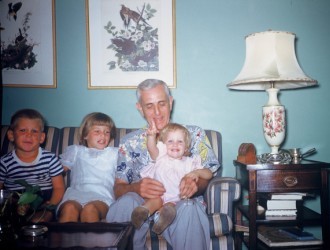
This is a sample of his superb craftsmanship from the late 1930's with a very unusual grid cut. It's the only one of his puzzles we have like it. The poster sized puzzle is approx. 15 " x 19 " and 475 pieces.
|
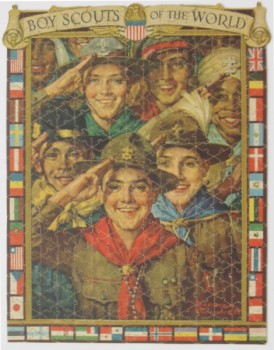
|
I enjoy cutting a few different styles of Wooden Jigsaw Puzzle but prefer the traditional knob and earlet. Shape variations of the knob make them somewhat distinct and aid in piece recognition especially for puzzles with a great number of pieces with similar color.
The puzzle is cut free-hand while looking at the picture with an extremely fine scroll saw blade, and, of course, a power scroll saw.
Each puzzle is therefore unique. As I cut each puzzle I look for deceptive possibilities along color lines, sometimes creating false edge pieces, and creating unusual shapes as I guide the cutting blade.
|
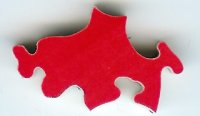
Puzzles cut with the traditional knob offer a strong interlocking pattern. There's nothing like the feel of a 1/4" plywood puzzle cut with an extremely fine blade when you assemble it. Each piece fits precisely in it place and nowhere else.
|

|
Close up of a puzzle piece showing the 1/4" plywood edge.
This type of plywood offers unmatched rigidity, stability and strength for a puzzle that will last a lifetime.
|
This is the style of the traditional stamped cardboard puzzle we are all familiar with.
Handling each finely crafted plywood piece and fitting it in place is a much more enjoyable experience. |
|
Adding a wavy edge increases the difficulty of a jigsaw puzzle but when internal pieces are given the same radius arch it can be even more challenging.
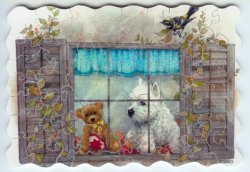
|
The tracing cut around the bear increases visual attention in the assembled puzzle as an import subject in the picture. Keeping a few knobs holds it firmly to the rest of the puzzle.
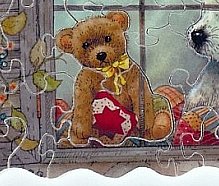
In the dark section the wavy line is treated with a variety of lengths however in the white section similarity of cut placement is used to increase the challenge for a small greeting card sized puzzle.
|
|
Another example of keeping distinctive features intact - It takes extra time and care to guide the cutting blade around faces and items of interest in the image but it is well worth the effort.
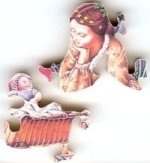
|
|
Close ups of the bride, groom, and Grandparents.

|
Boxed and ready to ship with a few teaser pieces on top. |
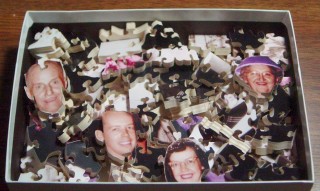
|
When a jigsaw cut follows the outer contour of the subject the puzzle can be much more difficult to solve. 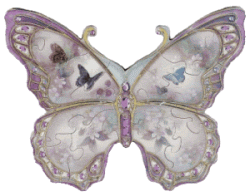
|
|
Enjoy mini Puzzles? How about one for a sports fan...
Send me a sports logo postcard or pick up out your favorite team's calendar on their web site, full of all kinds of great pictures.

|
|
|
Do you know a Stamp Collector?
Coin Collector?
These little novelties have about 12 pieces and are made from the stamp. I'll need a photo of the coin you want to present as a puzzle.
coin puzzle posibilities: www.morguefile.com/archive/?display=55022
www.morguefile.com/archive/?display=146890
|


